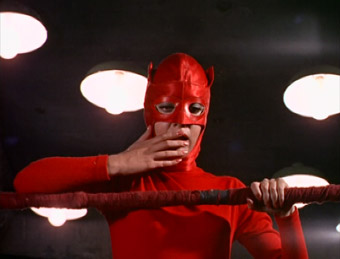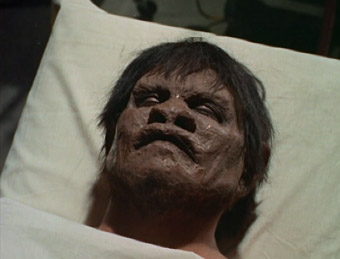|
What
is it with apes? Strike that, what WAS it with apes? Back
in days of cinema yore, there was nothing more frightening
than an ape on the rampage. And I'm not talking the oversized
King Kong variety, but the sort you'll find at the
local zoo. Actually, strike that. The sort of apes that
once terrified cinema audiences looked suspiciously like blokes in hairy
costumes. Which is what they were, of course. Real apes
don't take screen direction well. And if they get angry,
well, they might actually attack that screaming actress, or even worse
the director. No wonder audiences were nervous of them.
Times
change. David Attenborough sat with gorillas and whispered
at the camera, Sigourney Weaver found them in the mist,
and apes and their kindred species found their rightful
place as stars of natural history documentaries. Interesting
though they may be, they are not all that scary, at least not as
horror film monsters. Even oversized apes no longer seem
threatening. Nice try, though, Mr. Jackson.

Night
of the Bloody Apes [La Horripilante bestia
humana] is a lurid but not strictly accurate title.
Some of it takes place at night, for sure, but there's only
one ape, and he doesn't last long. That said, by the time the transplant
doctor has finished with him, he's certainly bloody. Of
course the term could be intended as a curse, as in "those
bloody apes are in the garden again, dear."
This is a Mexican horror film from 1969 and directed
by Rene Cardona. Hardcore horror devotees should be able to
connect those three facts and come up with a reasonably
close approximation of what we have here. So what DO we
have here? In essence, two films that have been surgically
attached to each other, sewn together by a director unconcerned
about leaving a very visible scar. In the red corner we
have a Mexican Lucha Libre wrestling film, in which masked
female wrestler Lucy debates quitting the ring after her
opponent is seriously injured. In the blue we have doctor
Krallman, whose son Julio is dying of leukaemia and whom
he attempts to cure by replacing his failing heart with
that of a healthy gorilla. A man-in-a-hairy-suit gorilla at that.
Just minutes after the operation is deemed a success, Julio's
head optically dissolves into that of a half-human ape man,
transforming this handsome youth into a malformed, Lou Ferringo-era Incredible Hulk, complete with the green man's bad temper
and angry snarls. He immediately goes on the rampage, tearing
the clothes off of women, pushing out eyes, pulling off
heads and ripping off toupees. The Doctor is mortified,
and reasons that the only way to put things right is to
replace the gorilla heart with a human one. Want to guess
whose? You'd probably be wrong.
Apparently
a remake of Cardona's own 1963 Doctor of Doom [Las Luchadoras contra el médico asesino],
which I haven't seen, this is very much a film of its place
and time. Back then, it seems, the idea of a rampaging monster was thought to be
enough to have couples clutching each other at drive-ins, with gore
effects, real-life heart operation footage, and some female nudity thrown
in for the boys. A hangover from Hammer, meanwhile, is represented
by a crippled assistant ("Yes, master") and Julio's
werewolf-like return to human form. Non-hardcore horror
fans need not apply. Indeed, it's safe to say that they will
probably react with disbelief at what's served up here. Cheapjack
in the way that only a late period Rene Cardona production
could be, it looks and plays for all the world like a rediscovered
Ed Wood film, with its super-basic sets, found-in-the-garage
props, and hilariously earnest and unconvincing performances,
although the sometimes emotionless English dubbing has to
take a lot of the blame here. If, however, micro-budget
1970s Mexican tit-and-gore horrors are your bag (guilty
as charged), then you should have a ball.

As
far as I am aware this version was not edited for the DVD
release, but cuts have clearly been made earlier in the
life of this particular print, indicated by the sudden jumps
in the backing music during some of the nastier visuals.
The BBFC site indicates that the original version, submitted
back in 1974, had the following adjustments made to obtain
the ‘X' rating:
"To
obtain this category cuts were required but details are
not available."
Running
time comparisons suggest that this is the uncut version and I have to presume that the visible edits were made before
the film was first released onto the international market.
Framed 1.33:1,
as you'd expect, but the print is otherwise in surprisingly
good shape – it's sharp, the colours are strong, the contrast
looks fine, and there aren't many dust spots. Odd bits of
damage pop up occasionally, and three shots suffer from
a mad jitter, but that's about it.
The
sound is mono Dolby 2.0 mono and is largely clean, though
does come out with the odd crackle here and there.
Very
little here. Promo Art contains
a Spanish poster, a VHS sleeve and the US DVD cover, and
there are 5 Stills from the film
that look suspiciously like cropped frame grabs. There are
also Trailers for two other Redemption
releases, Jean Rollin's Requiem for a Vampire
and Les Démoniaques.
There's
a narrow, some might say specialist audience for films like
Night of the Bloody Apes, and a good many
of them will already have heard of it and even have it on
tape or imported DVD. For them the news is good, as the
print on this Redemption DVD is far better than I was expecting.
No real extras, which is a shame.
If
you're fan of the cinema of Ed Wood then I really would
recommend taking a look, as the film has Wood's cheerful
disregard for the limitations of budget or the necessity
for realism, and the park scene in particular captures the
feel of Wood's faked exteriors as well as anything I've
seen in a long while. If you like your horror films glossy,
complex and handsomely produced, however, you just MIGHT
want to give this one a miss.
|